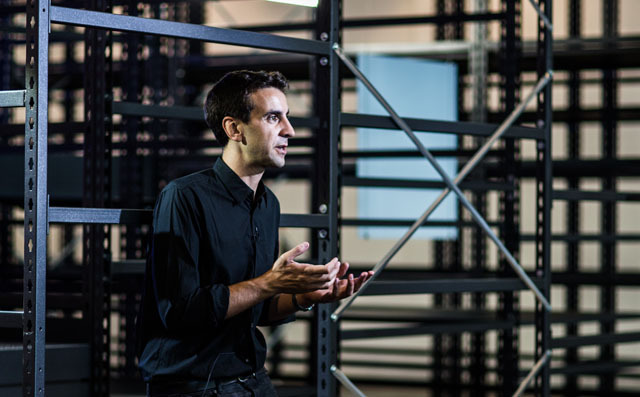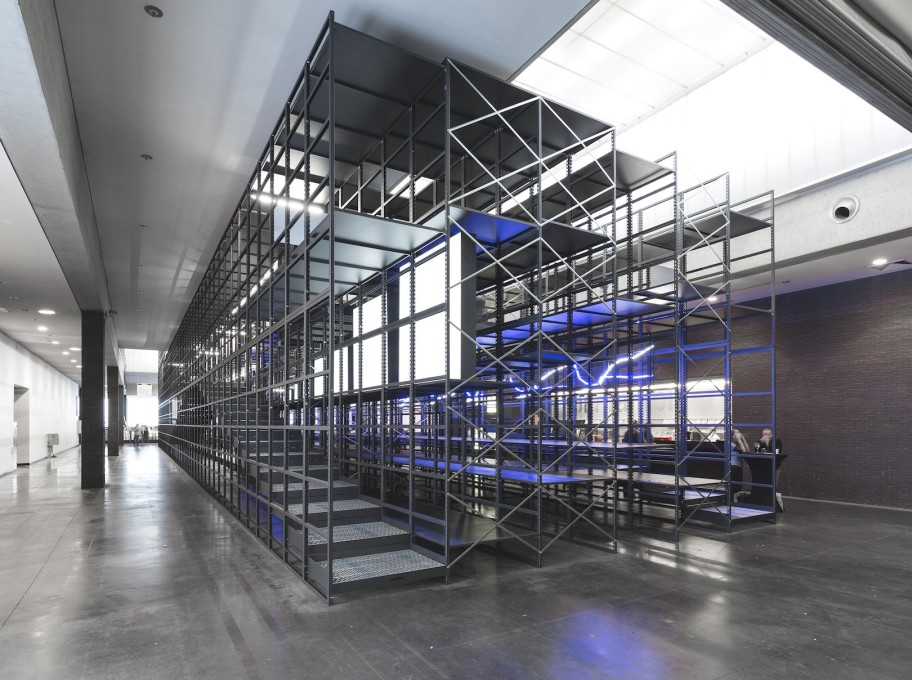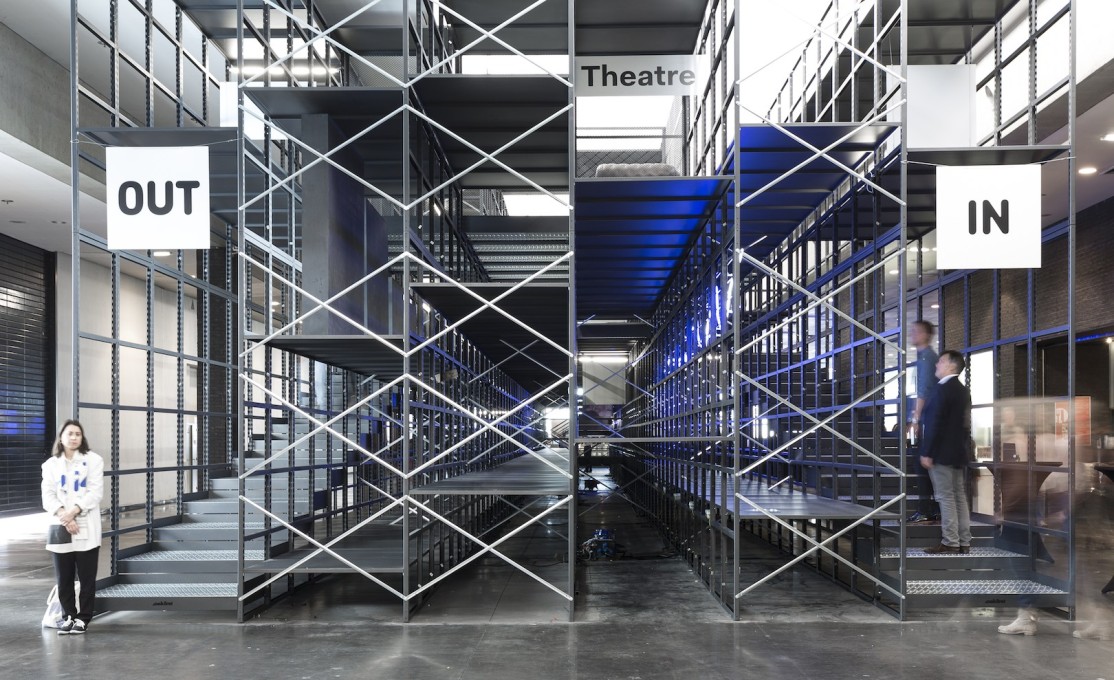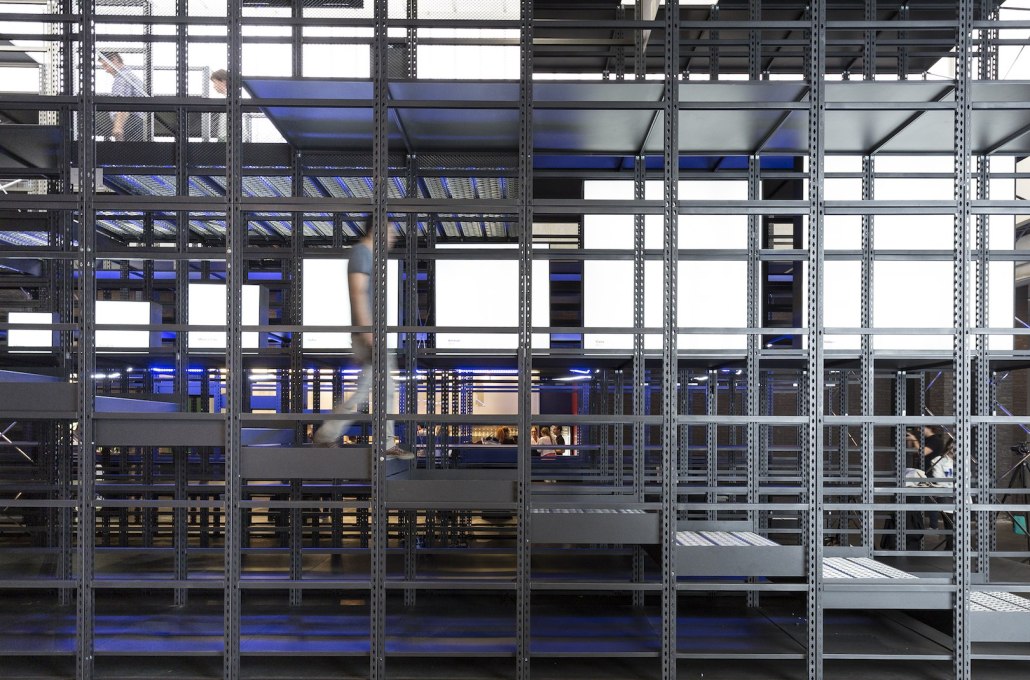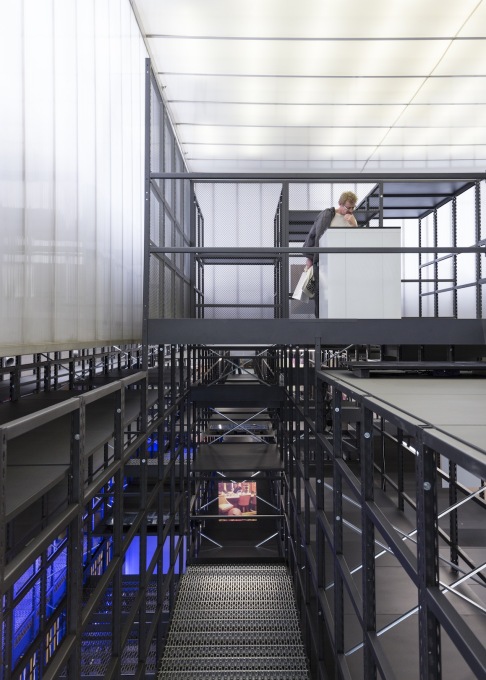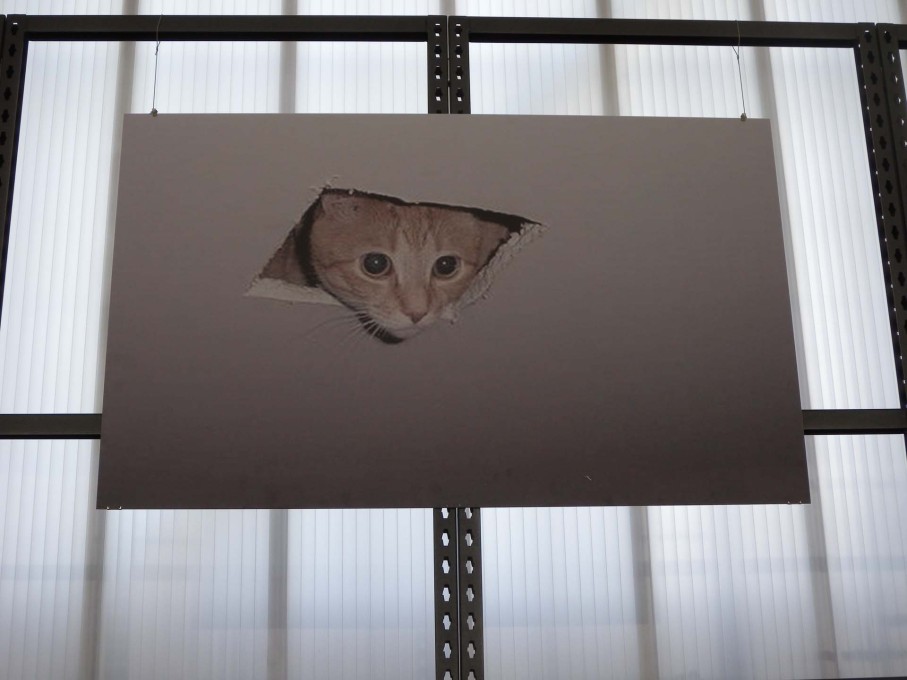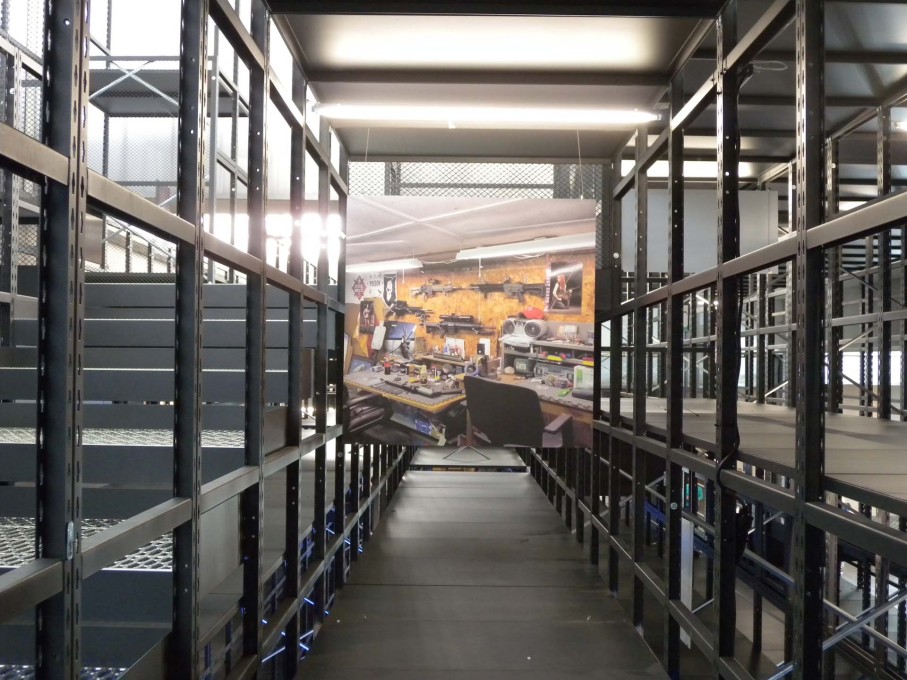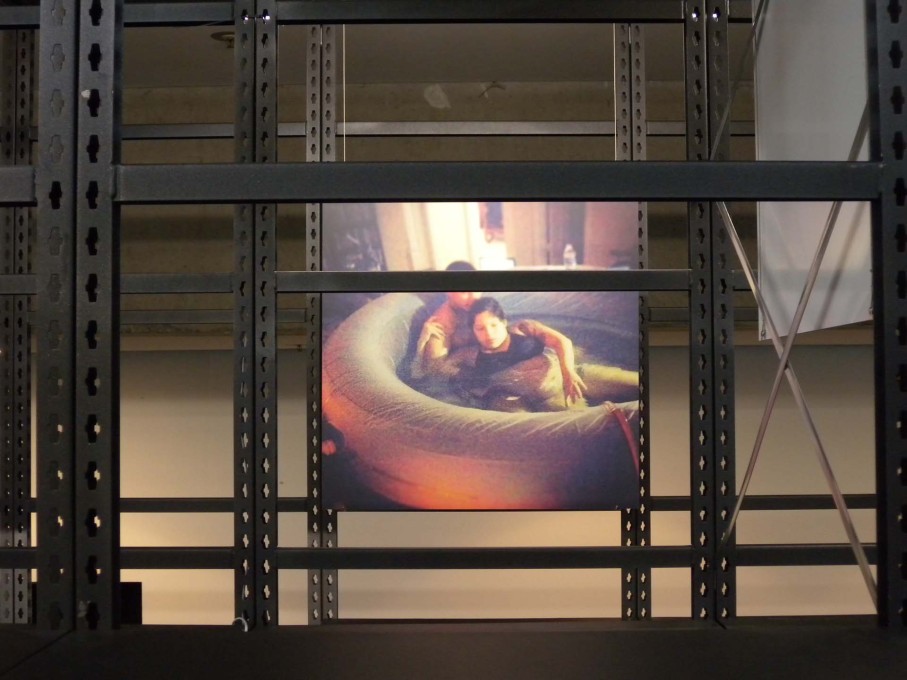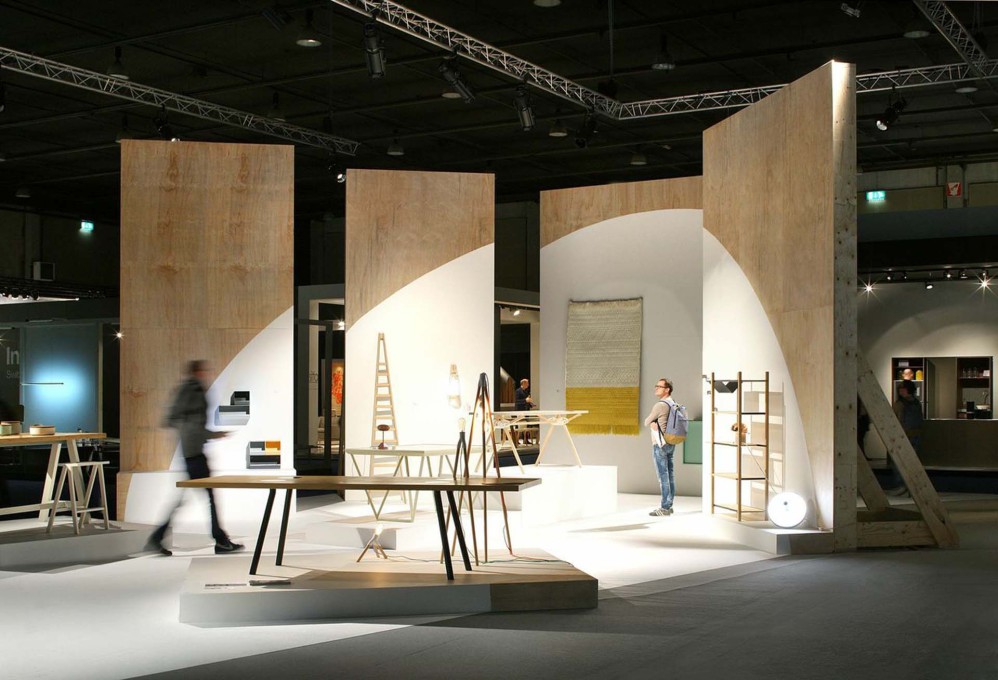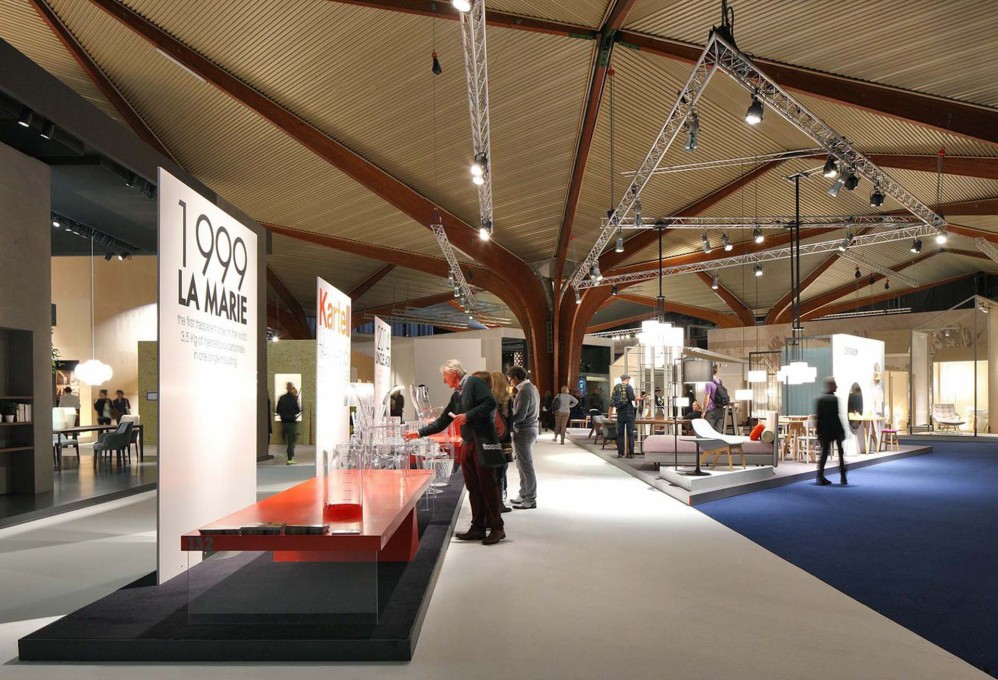Architect Joseph Grima is a recent former editor of Domus magazine and has made a name for himself as a curator of exhibitions exploring pressing issues facing design. He and his team at his design office, Space Caviar, were invited to curate the cultural programme for this year’s Kortrijk Bienniale Interieur design fair, but what they ended up doing was challenging the relevance of the entire event.
Under the umbrella title SQM: The Home Does Not Exist, Space Caviar’s main exhibition at the fair site, titled The Theatre of Everyday Life, was mounted on a scaffolding-like structure in the middle of the fair and showed a myriad of home lives as reflected through domestic images and films from public platforms such as Facebook and Pinterest. The exhibition – together with a specially-produced film called Fortess of Solitude – asks some pretty awkward and challenging questions in the context of an upmarket interiors fair such as: “Do we even need furniture?” Grima talked to uncube’s Sophie Lovell about why such discussions are long overdue – and not just for the furniture industry.
We both recently visited the oldest design Biennale in Europe, the BIO 50 in Ljubljana, and now we are at the second oldest, founded in 1968 in Kortrijk, Belgium. How would you compare the two?
I think what’s happening to them is incredibly exciting and interesting. I think they were two biennales that were a little bit dormant, if you look at the past 10 to 20 years. That’s not to say that they weren’t doing great things, but they were conforming to a model that perhaps has less relevance today than it used to. So I think the arrival of the new president at the Kortrijk Biennale Interieur, Lowie Vermeersch, is very important and exciting. In particular, there is his openness to using this not just as a platform for making impressive forms and structures – though we hope we’ve succeeded in doing that too – but asking bigger questions. Why are we actually here talking about design? What is the point of us being here? Does anybody care or are we just wasting our time?
You talk a lot about “crisis” and the word comes up again and again these days. There was obviously the financial crisis in 2007-2008, but there is an ongoing crisis too in the manufacturing industry: how people buy, how people produce and so on. I suppose it’s become an issue that is more urgent than just reacting to change. How would you define “crisis” in respect to the design industry?
I think there is a very simple example that drives home the point. If you imagine yourself transported back to the first Kortrijk Biennale Interieur in 1968, it does not take much imagination to get there. Maybe the colour or the form of that sofa would have been slightly different, but it would still be a sofa. The whole of this exhibition apparatus has not fundamentally changed since then. If you contrast the past with the typical changes that have invested the way that we live, the way that we move, the amount of time we spend at home, the activities that we conduct in the home, the way that networks and technology have transformed our homes…so many things have changed and yet we are still talking about design in the same way. We are still designing and producing design in exactly the same way as back then when we were dealing with completely different problems and completely different questions. What we’re really trying to do with this project SQM: The Home Does Not Exist is shake people up.
For example, we deliberately designed the structure here to be something that has a very different architectural language to that of the home. It’s not about sofas and lampshades. It’s a cold clinical, almost sci-fi environment where you can really take a step back from all the received ideas about the home and look instead at the evidence of everyday life we’ve collected together. It gives the opportunity to reconsider the forces at play in the domestic sphere today, which is something that hasn’t been done for a long time.
The structure of your exhibition at the fair looks a bit like a cross between Neuromancer and the Matrix...
Exactly, going into the files and being absorbed by the network…
This is something I often ask myself as an editor and writer too: how do you see your role and your responsibility in this time of change?
Well, my own activity is quite polymorphous. I’m an architect by training. Over the past ten years I’ve become interested in continually adding new languages to the ways that we can talk about the questions in the field. About a year and a half ago I founded Space Caviar with my partner Tamar Shafrir in Genoa. It was an attempt to propose a new type of design studio, which uses the tools and language of design – one capable of designing, for example, a space for talks to take place – but also of integrating vertically what in technology circles is called the “full sap” – the entire design process. Meaning: thinking of everything from the practicality of nuts and bolts right up to articulating the complex questions and researches around it. We also have the language and capacity to communicate these through producing films like SQM: Fortress of Solitude that we’re presenting here. We are able to bring together group of people who can speak all these different languages, collaborate and deliver a message that transcends any one of the languages on their own, whether it is a design reaction to the home or an artistic reaction to the question of mobility and nomadism.
Ultimately I do see myself as an architect or designer, but I’m also interested in journalism and communication. I think that what we’re attempting to do here through all these things, in a context not normally very suited to it, is to infiltrate this landscape of designers and manufacturers and establish a conversation with them.
I was listening to a talk recently between architects in Berlin and it struck me that architects seem to be way behind in this discussion compared to designers. A couple of years ago I was part of a similar discussion amongst designers and it struck me then that the were way behind in this discussion about crisis and change compared to the music industry…
Absolutely, I couldn’t agree more.
…and I get the sense that this discussion has to massively move on in architecture as well as just design.
Yes. At this moment, until there’s a fundamental shift, I think architecture is in many ways – I don’t want to use too strong a term – a lost cause in terms of its ability to produce anything that is bringing any sort of relevant ideas to the table. I think there are infinitely more interesting ideas being developed in design. This was essentially the point of the three years I spent at Domus magazine where I was attempting to chart the discrepancy between the architectural world that we were forced to speak of and the way that design was so much more compelling in terms of the ideas being developed there. But at the same time I think there is a tendency for design to become locked into a certain language and lack the ability to transcend it.
One of the reasons that this exhibit came about is that there’s a need in this kind of context for a high-impact installation: the scale is very large. What generally occurs is that a ton of sheetrock walling, metal and stuff is welded together to build up a thing that then gets chucked out at the end. Processes of that kind are something that I couldn’t be more in disagreement with. So we used industrial shelving, which is one of those things that lends itself well to mounting demands of this kind. This is something that has been woefully lacking in contemporary thinking on architectural production. But if you think of Lina Bo Bardi’s Teatro Oficina in São Paolo or Cedric Price’s Fun Palace, a lot of their work was based on structures that are not permanent, and which are extremely frugal in terms of materials and components used. Even with Renzo Piano’s Arco de Prometheo theatre from the early 1980s there was a culture of thinking about infrastructures as things that are not permanent, that adapt and respond to the context they are in. There is so much potential in these, now more than ever, and yet precisely in the moment where there is so much opportunity, so little is being produced like this.
Those three years that you were at Domus, was that a set period that you had been given?
Yes.
It felt that you really stretched the elastic during your time there and now it has snapped back to where it was before – exactly at the wrong time when publishing is also going through the same crisis and in danger of dying in a way. If the advertisers don’t shift with them in finding new models then we are all in trouble. But on the other hand, Justin McGuirk said in a talk in Ljubljana that the “rhetoric has overreached the reality”. How can manufacturers actually move on? What do they need to do to change?
I don’t know whether you saw the exhibition I organised in 2012 in Palazzo Clerici in Milan, during the Salone del Mobile, called Open Design Archipelago...
Yes I did…
That exhibition was incredibly influential in a really strange way – a way beyond what I’d expected. It was during my first year at Domus. The conversations that came out of it, not so much with the designers who had already established a dialogue, but with the manufacturers, were incredibly interesting. Even today I’m still talking to them and in the process of introducing ideas derived from that exhibition. It’s a slow process and takes time to be absorbed into the mainstream economy, but it’s happening.
That show then moved on as Adhocracy at the Istanbul Design Biennale, where we developed it even further.
Can you name a concrete example of how a manufacturer is responding and adapting?
Right now? None. But it will come.
No, I can name one: a really good example is Open Desk in London. They are not a furniture company, but a technology company that has taken the problem of furniture and is busy disrupting some of the really big players by using a really Silicon Valley attitude towards addressing the problem of people needing affordable but decent furniture. They’ve asked how we are going to establish a network that can take advantage of the technological opportunities that are offered by CNC [computer numerically controlled] mills – available pretty much everywhere in the world – and disrupt something like Ikea, for example, which is just swallowing the whole of the low end of the furniture market.
Is it a company that does production on demand?
Yes, everything is produced on demand, everything is downloadable for free, completely open source. They just completed their first round of funding that hit, I think, 250,000 GBP through individual contributions in one day.
But are they actually earning money from it?
I think they are earning a bit. But this is the kind of approach that companies like Facebook and Twitter take, where first you capture an audience, and then you monetise that audience. I’m not saying that this is some kind of manna from heaven, but it’s an approach that is desperately needed in this sort of world here [gestures to the furniture fair around him]. It’s unbelievable that we are still looking at the same sofas.
Technology was supposed to save us and change everything, but instead it has just added a fantasy virtual layer of “home” to the reality of what we already have. What you seem to be presenting here in your exhibition is the virtual fragmentation of the home, saying: here is the physical bit where we sleep and cook and use the bathroom and here is our virtual home that we post on Facebook and Pinterest and so on…but hasn’t this just made us sad and passive? Are we so busy updating Facebook that we don’t actually get around to living?
There is a really beautiful phrase in Fortress of Solitude, the film accompanying this exhibition: “We drift from network to network while our home is home alone cooking dinner.” The film is a beautiful story about a single mum and her relationship with her smart home. It’s along the lines of the film Her, the idea of a relationship between a person and an entity – in this case the home – mediated through social media. It expresses this disconnect with the home that needs to absorb the practical demands of daily life. Just look at all the pictures in the exhibition that people have captured of their daily life and put out into the public realm… I don’t know if it’s making us more passive, but things are definitely changing: there isn’t any way back. There is no point even in taking a moralistic attitude towards it. But sometimes one is tempted to be critical and think about what our own political responsibilities are in relation to the home: How do we safeguard a moment that is not part of the economy, not part of the media circus? The part where we are disconnected, where we are intimate, which I think is the thing being lost at the moment.
– Sophie Lovell
SQM: The Home Does Not Exist is part of the 24th International Kortrijk Biennale Interieur, 17-26 October 2014-10-29
Further reading: SQM: The Quantified Home, ed. Space Caviar, pub. Lars Müller, 2014




